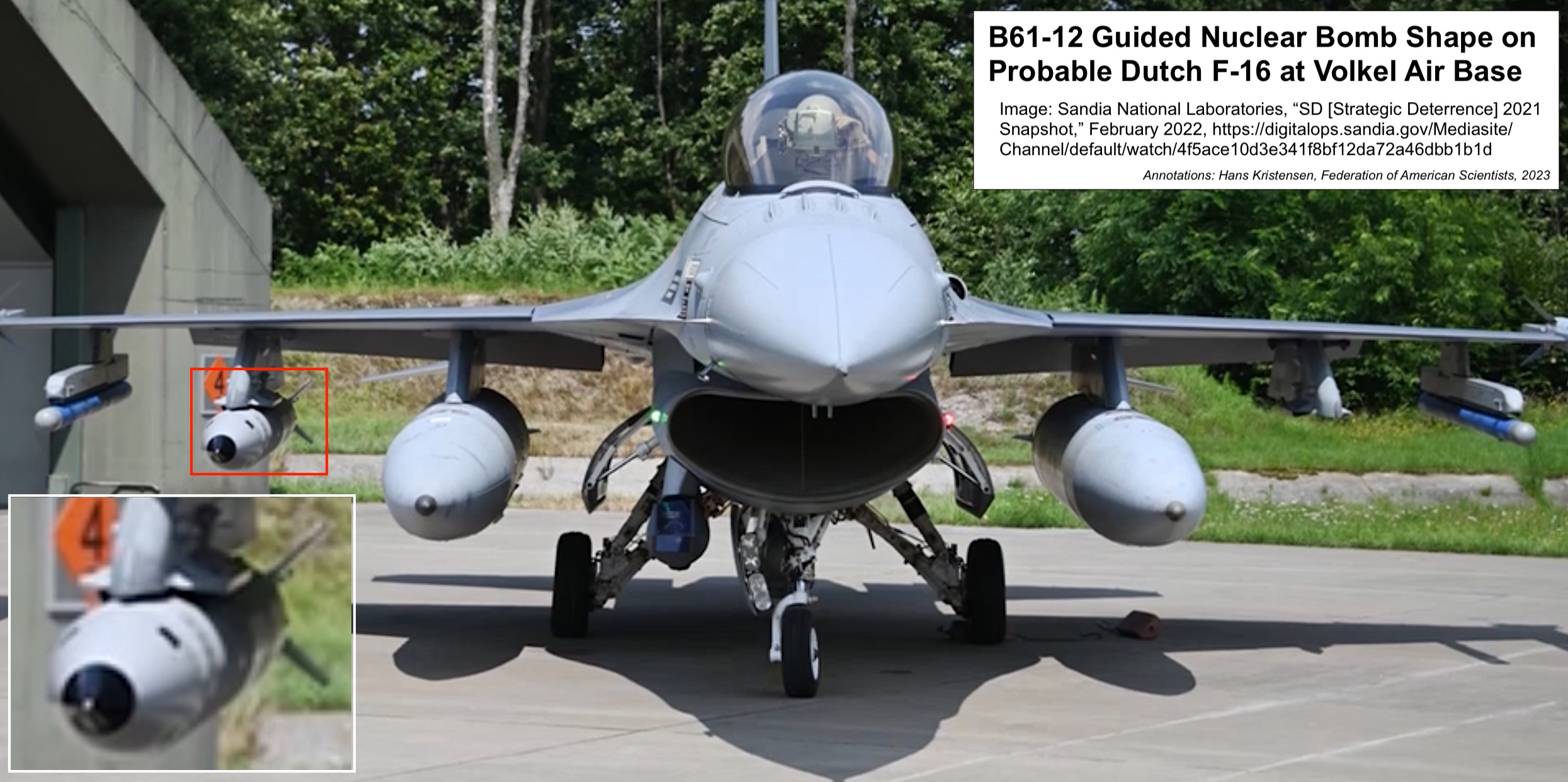A photo of an F-16 Viper with a training version of the B61-12 nuclear gravity bomb, or “shape,” beneath its wing has surfaced on the internet, with the aircraft reportedly parked at Volkel Air Base in the Netherlands.
At Par With US Gray Eagles! China’s Combat Fleet Of Wing Loong UAVs To Become ‘Smarter, Deadlier’ With AI
Even though the Netherlands does not have nuclear weapons, NATO’s ‘Nuclear Sharing’ doctrine enables members without nukes of their own to take part in NATO’s nuclear deployment. The photograph has incidentally emerged when both NATO and Russian camps have undertaken a stern nuclear posturing.
However, there is a twist. The photograph predates the Russian invasion of Ukraine and the spate of hostilities that began in early 2022. The picture of the F-16 with the B61-12 under its wing was featured in a video montage released by the Department of Energy’s Sandia National Laboratories last year.
The video was published to highlight the achievements of the department from the year 2021 and caught the eye of Hans Kristensen, the head of the Nuclear Information Project at the Federation of American Scientists (FAS) think tank in Washington, D.C., who put out a detailed assessment on the official website on December 12.
Hans determined that the photo was shot at Volkel based on the unique design of the reinforced aircraft shelter visible to the left of the F-16 in the Sandia film.
According to FAS, “Eleven of the [32] shelters at the Volkel [air base] are equipped with an underground vault that can hold up to four B61 bombs. But normally, they only hold 1-2 bombs each for an estimated 10-15 at the base.”
“A picture posted on a public forum shows the outline of a vault inside a Protective Aircraft Shelter at Volkel Air Base.”
The training B61-12 is affixed to an F-16, but the armament is not yet part of the NATO fighter fleet. The US Department of Energy had observed earlier that while the B61-12 has been added to the country’s nuclear weapons arsenal, it is now only designated for use with the B-2 strategic bomber.

The National Nuclear Security Administration’s (NNSA) new unclassified Stockpile Stewardship and Management Plan (SSMP) 2024 report published on November 27 said that the B61-12 nuclear bomb has officially become a part of the US nuclear stockpile and approved for use on the B-2A Spirit stealth bomber, as recently reported by EurAsian Times. The NNSA, together with the US military, manages the country’s nuclear stockpile.
Hans noted that the Dutch air base at Volkel seems to have begun integration training with it in 2021, even before the new B61-12 guided nuclear gravity bomb got into total production and was added to the American stockpile in 2022. This suggests that the preparations for deploying nuclear weapons in the European theatre have been going on for a while and did not begin with the Russian invasion of Ukraine in 2022.
However, the invasion and the following nuclear brinksmanship may have expedited the process.
Reports in October 2022, for instance, indicated that the US has rushed deploying a more precise version of its standard nuclear weapon to European NATO locations. At the time, the reports noted that the arrival of the upgraded B61-12 air-dropped gravity bomb was planned for December 2022.
The latest B61-12 bomb is expected to gradually replace the older models, such as the B61-3, -4, and -7, according to reports over the years. However, a timeline for that remains elusive for now.
The B61-12 is an 825-pound, 12-foot-long bomb with an inertial navigation system (INS) guidance package. It comprises both new parts — such as the precision guiding tail kit and reconditioned components, all of which have varying yields — from the previous B61 variants.
It appears that training with the new U.S. B61-12 nuclear bomb has been happening in Europe for a couple of years. This image from 2021 shows a B61-12 training shape under the wing of a Dutch F-16 at Volkel Air Base.
More info here: https://t.co/3MDEbSouuo pic.twitter.com/fEygtBOspT
— Hans Kristensen (@nukestrat) December 13, 2023
The recent photos also show that the B61-12’s tail section differs significantly from previous B61 models. This nuclear weapon is unique in its rear end since the B61-12 is the first to have a precision-guided tail kit. Together with the new tail and other enhancements, the B61-12 is an amalgam of parts from several previous B61 models.
It is anticipated that B61-12 will be installed on a few NATO F-16s and US Air Force Vipers. Under NATO’s nuclear sharing agreements, certain Belgian Vipers and those in Dutch service are currently authorized to use older B61 types. It is possible to use certain of the Panavia Tornado swing-wing combat jets that are now in use in Germany and Italy as platforms for delivering nuclear weapons.
The F-35s of the Dutch Air Force are also being readied to be equipped with B16-12 nuclear gravity bombs, in what has laid bare the US eagerness to field nuclear weapons in Europe. This becomes more significant in the wake of Russia’s threatening use of nukes on multiple occasions through the ongoing war and moving nuclear ballistic missiles to Belarus.
B61-12s will likely replace the 150 or so earlier B61 versions that are now housed at six locations in Europe. This includes bombs stationed in places in Belgium, Germany, Italy, and the Netherlands, where the Dutch Volkel Air Base is home to ten to fifteen B61 nuclear bombs that RNLAF F-16s deliver.
Dutch F-35A Fighters Readying For Nuke Strike Missions
There are signs that the US is helping the Dutch F-35A fulfill its function as a nuclear carrier platform, months after Russia’s ally Belarus obtained tactical nuclear weapons from Moscow.
The Netherlands declared that it had received “initial certification for the deterrence mission” amidst heightened nuclear threats over Europe, implying that some of the F-35A stealth aircraft in NATO’s fleet are moving closer to being completely nuclear-capable.
The Dutch Air Combat Command commander Johan van Deventer posted on X: “#ACC “Ready for Operations” from the US team that inspected us this week. This gives us our initial certification for the deterrence mission with the F-35. An important step in the transition. Made possible by teamwork.”
An earlier declaration from the US Air Force stated that the F-35A would be certified as a “Dual Capable Aircraft (DCA)” by January 2024, meaning it could carry the B61-12 nuclear bomb. The US Air Force has not yet revealed whether any other nation or its F-35A aircraft has been certified to use the B61-12.
:quality(70)/cloudfront-us-east-1.images.arcpublishing.com/archetype/UD2ZX53GB5AI5D6HQYBCJ4X5CY.jpg)
Early in 2024, the Royal Netherlands Air Force (RNLAF) plans to declare its F-35A is fully operational. That declaration, though, won’t come until the F-35A fighter has accomplished every task assigned to it. With work progressing steadily on turning the aircraft into a nuclear carrier, the integration of B61-12 would likely have to be completed before that.
US Air Force officers visited the Dutch Air Combat Command to assess the operational readiness of the F-35A fleet of the Royal Netherlands Air Force (RNLAF). Even though it’s uncertain if the bombs have been made accessible to date, the certification that goes along with them was based on an assessment of the RNLAF’s ability to carry out the nuclear attack mission using the F-35A.
Additionally, a picture of an RNLAF F-35A equipped with test versions of B61-12 nuclear bombs was released.
To determine whether the B61-12 nuclear weapon was compatible with the F-35A, the US Air Force conducted the required flight testing, which was finished in 2021. The agency noted that the airframe still required approval for nuclear operations. One of the nation’s future nuclear goals is to equip the stealthy F-35 with nuclear weapons.
- Contact the author at sakshi.tiwari9555 (at) gmail.com
- Follow EurAsian Times on Google News




